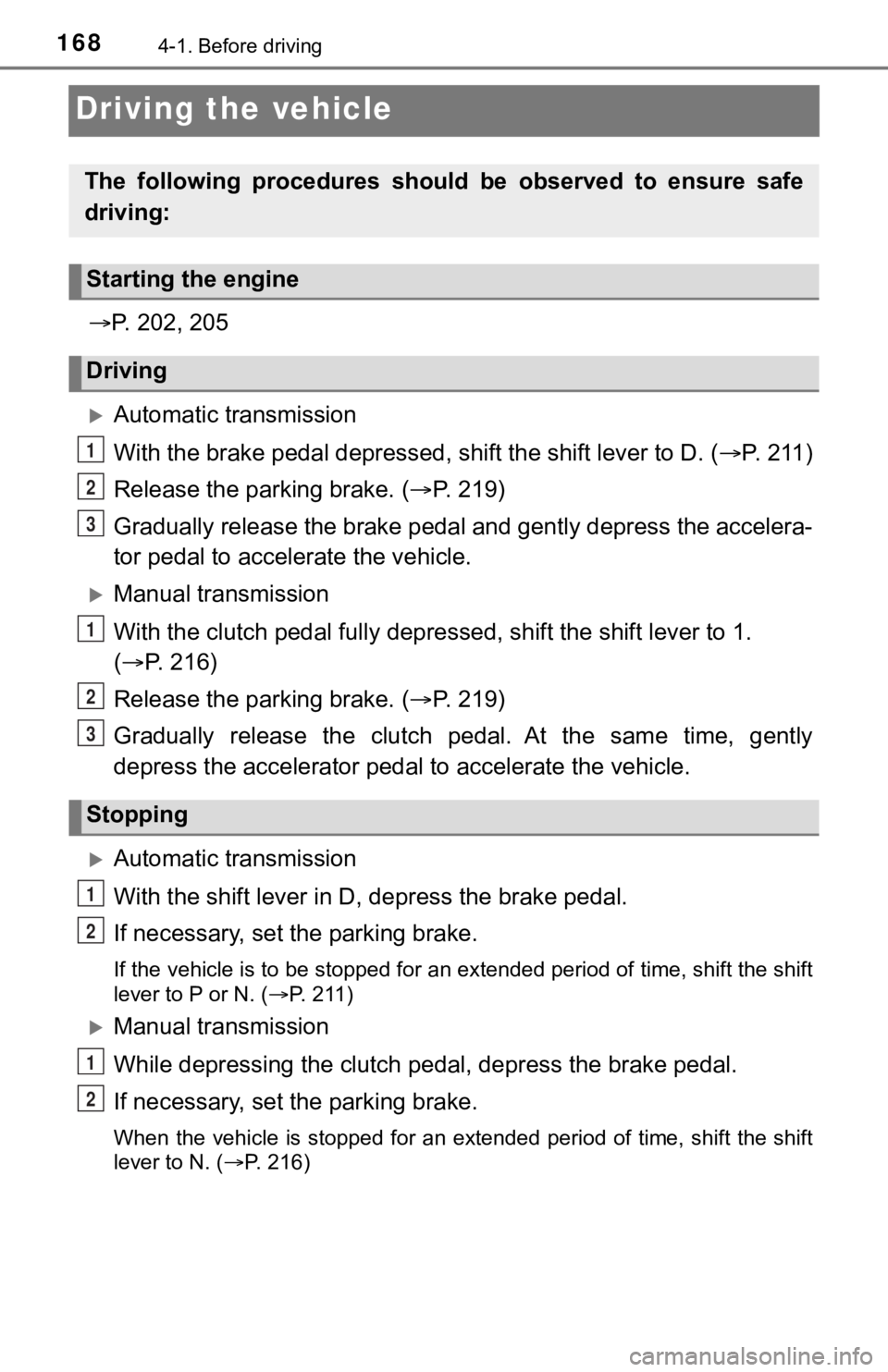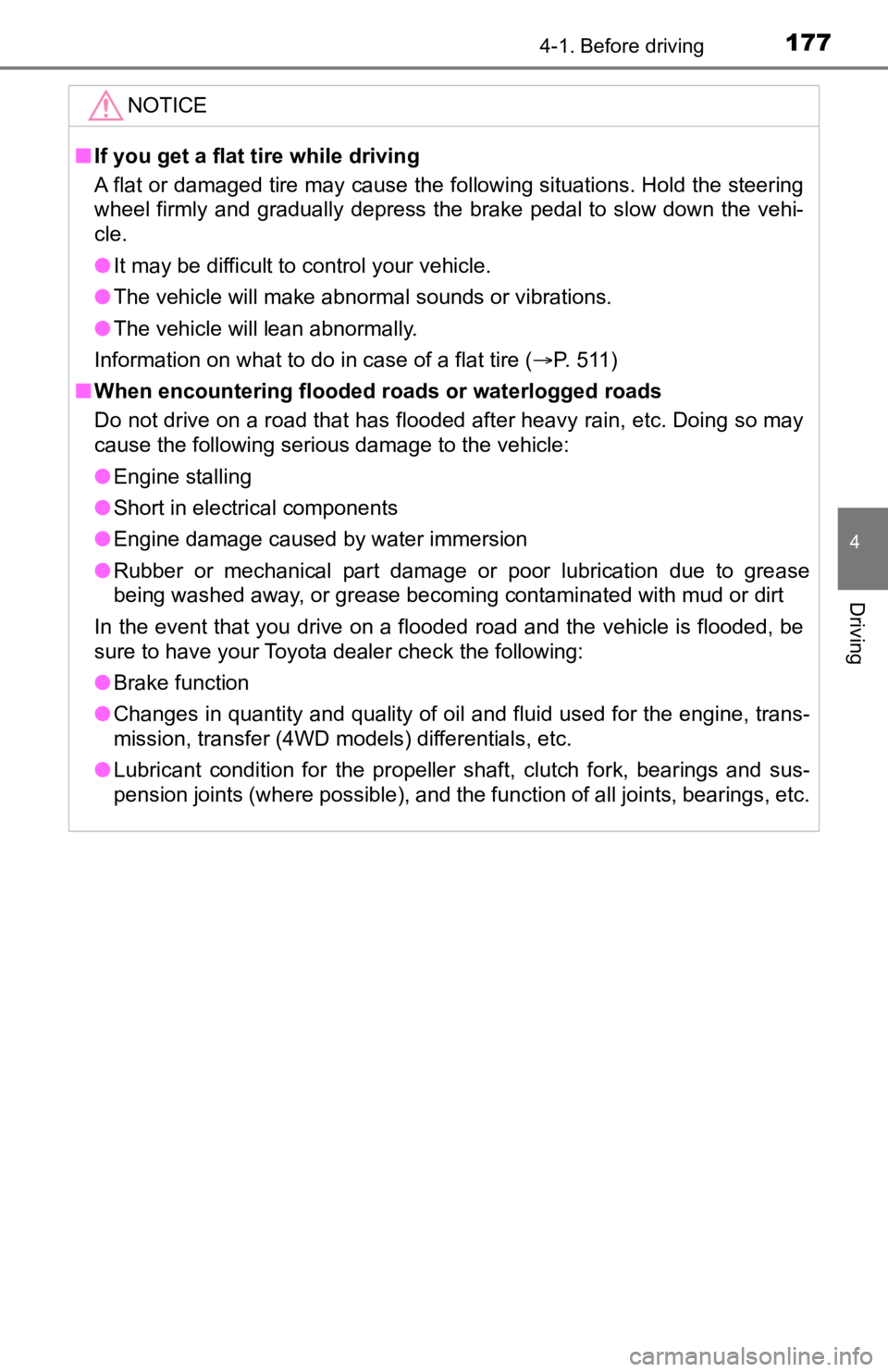2023 TOYOTA TACOMA clutch
[x] Cancel search: clutchPage 3 of 616

3
1
8 7 5 4
3
2
9
6
4-1. Before drivingDriving the vehicle ............. 168
Cargo and luggage............ 178
Vehicle load limits ............. 182
Trailer towing..................... 183
Dinghy towing.................... 201
4-2. Driving procedures Engine (ignition) switch (vehicles without
a smart key system) ........ 202
Engine (ignition) switch (vehicles with a smart
key system) ..................... 205
Automatic transmission ..... 211
Manual transmission ......... 216
Turn signal lever................ 218
Parking brake .................... 219
4-3. Operating the lights and wipers
Headlight switch ................ 220
Automatic High Beam ....... 224
Fog light switch ................. 229
Windshield wipers and washer ............................ 230
4-4. Refueling Opening the fuel tank cap.................... 233 4-5. Using the driving support
systems
Toyota Safety Sense P ...... 237
PCS (Pre-Collision System)..... 245
LDA (Lane Departure Alert)..... 258
Dynamic radar cruise control ................... 266
Cruise control .................... 280
Intuitive parking assist ....... 284
BSM (Blind Spot Monitor)......... 292
• The Blind Spot Monitor function.......................... 294
• The Rear Cross Traffic Alert function ................. 297
Four-wheel drive system ... 303
AUTO LSD system ............ 307
Rear differential lock system ............................. 309
Active traction control system ............................. 312
Multi-terrain Select............. 314
Crawl Control ..................... 318
Clutch start cancel switch .............................. 322
Driving assist systems ....... 323
4-6. Driving tips Winter driving tips .............. 329
Off-road precautions .......... 333
4Driving
Page 20 of 616

20Pictorial index
■Switches
VSC off switch . . . . . . . . . . . . . . . . . . . . . . . . . . . . P. 307, 324, 325
VIEW switch
*4
Cargo lamp main switch*1 . . . . . . . . . . . . . . . . . . . . . . . . . . P. 355
Automatic High Beam switch
*1 . . . . . . . . . . . . . . . . . . . . . . P. 224
Power outlet main switch
*1 . . . . . . . . . . . . . . . . . . . . . . . . . P. 376
“CLUTCH START CANCEL” switch
*2 . . . . . . . . . . . . . . . . . P. 322
Outside rear view mirror switch . . . . . . . . . . . . . . . . . . . . . . P. 154
Window lock switch . . . . . . . . . . . . . . . . . . . . . . . . . . . . . . . . P. 156
Door lock switches . . . . . . . . . . . . . . . . . . . . . . . . . . . . . . . . P. 121
Power window switches . . . . . . . . . . . . . . . . . . . . . . . . . . . . P. 156
Tire pressure warning reset switch
*1 . . . . . . . . . . . . . . . . . P. 433
1
2
3
4
5
6
7
8
9
10
11
Page 167 of 616

167
4Driving
4-4. RefuelingOpening the fuel tank cap.................... 233
4-5. Using the driving support systems
Toyota Safety Sense P ..... 237
PCS (Pre-Collision System) .... 245
LDA (Lane Departure Alert) .... 258
Dynamic radar cruise control ............................. 266
Cruise control .................... 280
Intuitive parking assist ....... 284
BSM (Blind Spot Monitor) ........ 292
• T he Blind Spot Monitor
function ......................... 294
• T he Rear Cross Traffic
Alert function ................. 297
Four-wheel drive system ... 303
AUTO LSD system ............ 307 Rear differential lock
system ............................ 309
Active traction control system ............................ 312
Multi-terrain Select ............ 314
Crawl Control .................... 318
Clutch start cancel switch .............................. 322
Driving assist systems ...... 323
4-6. Driving tips Winter driving tips ............. 329
Off-road precautions ......... 333
Page 168 of 616

1684-1. Before driving
Driving the vehicle
P. 202, 205
Automatic transmission
With the brake pedal depressed, shift the shift lever to D. (P. 2 1 1 )
Release the parking brake. ( P. 2 1 9 )
Gradually release the brake pedal and gently depress the accele ra-
tor pedal to accelerate the vehicle.
Manual transmission
With the clutch pedal fully depre ssed, shift the shift lever to 1.
( P. 216)
Release the parking brake. ( P. 2 1 9 )
Gradually release the clutch pedal. At the same time, gently
depress the accelerator pedal to accelerate the vehicle.
Automatic transmission
With the shift lever in D, depress the brake pedal.
If necessary, set the parking brake.
If the vehicle is to be stopped for an extended period of time, shift the shift
lever to P or N. ( P. 211)
Manual transmission
While depressing the clutch pedal, depress the brake pedal.
If necessary, set the parking brake.
When the vehicle is stopped for an extended period of time, shi ft the shift
lever to N. ( P. 216)
The following procedures should be observed to ensure safe
driving:
Starting the engine
Driving
Stopping
1
2
3
1
2
3
1
2
1
2
Page 169 of 616

1694-1. Before driving
4
Driving
Automatic transmission
With the shift lever in D, depress the brake pedal.
Set the parking brake ( P. 219), and shift the shift lever to P
( P. 211).
Vehicles without a smart key sys tem: Turn the engine switch to the
“LOCK” position to stop the engine.
Vehicles with a smart key system : Press the engine switch to stop
the engine.
Lock the door, making sure that you have the key on your person.
If parking on a hill, block the wheels as needed.
Manual transmission
While depressing the clutch pedal, depress the brake pedal.
Set the parking brake. ( P. 2 1 9 )
Shift the shift lever to N. ( P. 216)
If parking on a hill, shift the shift lever to 1 or R needed.
Turn the engine switch to the “LOC K” position to stop the engine.
Lock the door, making sure that you have the key on your person.
If parking on a hill, block the wheels as needed.
Automatic transmission
Make sure that the parking brake is set and shift the shift lev er to D.
Gently depress the accelerator pedal.
Release the parking brake.
Manual transmission
With the parking brake firmly set and the clutch pedal fully
depressed, shift the shift lever to 1.
Lightly depress the accelerato r pedal at the same time as gradu ally
releasing the clutch pedal.
Release the parking brake.
Parking the vehicle
Starting off on a steep uphill
1
2
3
4
1
2
3
4
5
1
2
3
1
2
3
Page 176 of 616

1764-1. Before driving
NOTICE
■When driving the vehicle
● Do not depress the accelerator and brake pedals at the same tim e during
driving, as this may restrain the engine output.
Vehicles with an automatic transmission
● Do not use the accelerator pedal or depress the accelerator and brake
pedals at the same time to hold the vehicle on a hill.
Vehicles with a manual transmission
● Do not shift gears unless the clutch pedal is fully depressed. After shifting,
do not release the clutch abruptly. Doing so may damage the clutch, trans-
mission and gears.
● Do not rest your foot on the clutch pedal while driving.
Doing so may cause clutch trouble.
● Do not use any gear other than the first gear when starting off and moving
forward.
Doing so may damage the clutch.
● Do not use the clutch to hold the vehicle when stopping on an uphill grade.
Doing so may damage the clutch.
● Do not shift the shift lever to R when the vehicle is still moving. Doing so
may damage the clutch, transmission and gears.
■ When parking the vehicle (vehicles with an automatic transmissi on)
Always set the parking brake, and shift the shift lever to P. Failure to do so
may cause the vehicle to move or the vehicle may move suddenly if the
accelerator pedal is accidentally depressed.
■ Avoiding damage to vehicle parts
● Do not turn the steering wheel fully in either direction and ho ld it there for
an extended period of time.
Doing so may damage the power steering pump.
● When driving over bumps in the road, drive as slowly as possible to avoid
damaging the wheels, underside of the vehicle, etc.
Page 177 of 616

1774-1. Before driving
4
Driving
NOTICE
■If you get a flat tire while driving
A flat or damaged tire may cause the following situations. Hold the steering
wheel firmly and gradually depress the brake pedal to slow down the vehi-
cle.
● It may be difficult to control your vehicle.
● The vehicle will make abnormal sounds or vibrations.
● The vehicle will lean abnormally.
Information on what to do in case of a flat tire ( P. 511)
■ When encountering flooded roads or waterlogged roads
Do not drive on a road that has flooded after heavy rain, etc. Doing so may
cause the following serious damage to the vehicle:
● Engine stalling
● Short in electrical components
● Engine damage caused by water immersion
● Rubber or mechanical part damage or poor lubrication due to grease
being washed away, or grease becoming contaminated with mud or dirt
In the event that you drive on a flooded road and the vehicle is flooded, be
sure to have your Toyota dealer check the following:
● Brake function
● Changes in quantity and quality of oil and fluid used for the engine, trans-
mission, transfer (4WD models) differentials, etc.
● Lubricant condition for the propeller shaft, clutch fork, beari ngs and sus-
pension joints (where possible), and the function of all joints, bearings, etc.
Page 195 of 616

1954-1. Before driving
4
Driving
●Always place wheel blocks under both the vehicle’s and the trai ler’s
wheels when parking. Apply the parking brake firmly, and put th e
transmission in P (automatic transmission) or in 1 or R (manual
transmission). Avoid parking on a slope, but if unavoidable, do so
only after perform ing the following:
Apply the brakes and keep them applied.
Have someone place wheel blocks under both the vehicle’s and
trailer’s wheels.
When the wheel blocks are in pl ace, release the brakes slowly
until the blocks absorb the load.
Apply the parking brake firmly.
Shift into P (automatic transmission) or 1 or R (manual transmi s-
sion) and turn off the engine.
● When restarting afte r parking on a slope:
With the transmission in P (autom atic transmission) or the clutch
pedal (manual transmission) depr essed, start the engine. On
vehicles with an automatic transmission, be sure to keep the
brake pedal pressed.
Shift into a forward gear. If reversing, shift into R.
Release the parking brake (and also the brake pedal on vehicles
with an automatic transmission), and slowly pull or back away
from the wheel blocks. S top and apply the brakes.
Have someone retrieve the blocks.
1
2
3
4
5
1
2
3
4